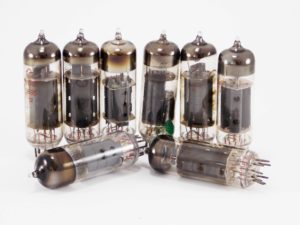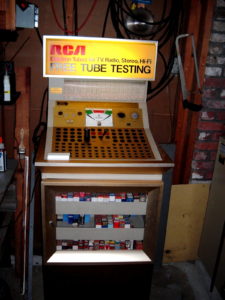
It was a blast growing up in the Jet Age. Sure, our parents saw rapid progress in their own lifetimes. They may have recalled a day when horse-drawn wagons were common on Main Street. They probably took rides on steam trains. And they could likely remember losing childhood friends to diseases that were quite curable or preventable by the time we came along.
But we had ELECTRONICS! Yes, electronics ran a tremendous percentage of the world that we grew up in.
And the electronics that our day-to-day life depended on so much were prone to frequent failure, thanks to components with very finite lifespans known as vacuum tubes.
Who knows, maybe embattled senator Ted Stevens, born in 1923, may have had the electronic versions somewhat in mind when he made his infamous “series of tubes” statement. Nah, probably not.
The transistor was perfected in 1947 by William Shockley. But it would be many years before it would completely replace the ubiquitous vacuum tube. In the meantime, radios, televisions, and stereo consoles were sold by the millions powered by electronic tubes.
Those tubes would act as sophisticated switches that would close when the current reached a certain voltage. When they worked their magic, it was possible to produce sound from electrical impulses. They generated heat, necessitating lots of ventilation holes on the devices in which they were installed. And they would glow in eerie shades of orange when they did their thing, as observed by myself peering through the small ventilation openings.
The light show would be accompanied by a peculiar aroma, caused by a combination of heat, ozone, and dust. It’s impossible to describe, yet, if you smelled it, you would never forget it.
I found the combination of sensory stimulations very fascinating, so much so that I sought careers in the electrical and electronics fields before settling in as a computer geek almost ten years ago.

Dad wasn’t nearly so taken by the show, of course. All he knew about an electronics-powered device was that when it quit, it QUIT. It was time to take the radio in, or call a repairman to the home in the case of a massive TV or stereo console.Theoretically, it was possible to yank all of the tubes from the sick gadget and haul them down to Farrier’s IGA, which had a tube tester.
The tube tester had a whole bunch of sockets, designed for every conceivable tube that could be found in the average consumer device. It had a dial that would pop into the green zone if the tube was okay, or stay in the dreaded yellow or red ranges if it was time to replace it.
The business hoped that you would purchase replacements for faulty tubes from them, of course, which is how they justified paying hundreds of dollars for a sophisticated tester that was free for public use.
If you found a bad tube, and the store had a replacement, you were back in business. That’s assuming that you could match all of the tubes you yanked back with their original sockets and got them all seated correctly.
A kid would also offer silent prayers that the TV repairman would be able to diagnose the problem tube while he had the TV back removed in the house. If he did, another plea to God would be made that he would have the replacement tube in the truck.
If not, the household would have to do without TV for a week or a month, which, you’ll recall, was several lifetimes for us when we were seven years old. It was even worse if he had to load the TV up and take it to the shop. We would stare mournfully at the empty spot in the living room, awaiting the interminable return of the one-eyed monster that we had grown to love so much.
Nowadays, the equivalent of the 1960’s burnt-out-tube might be the occasional interruption in internet access. A recent ice storm isolated me from the rest of the world for a day or so, and it felt pretty lonely.
But one sad fact makes any modern-day outages more bearable than the ones we experienced in childhood. Time passes much, much faster now than it used to.